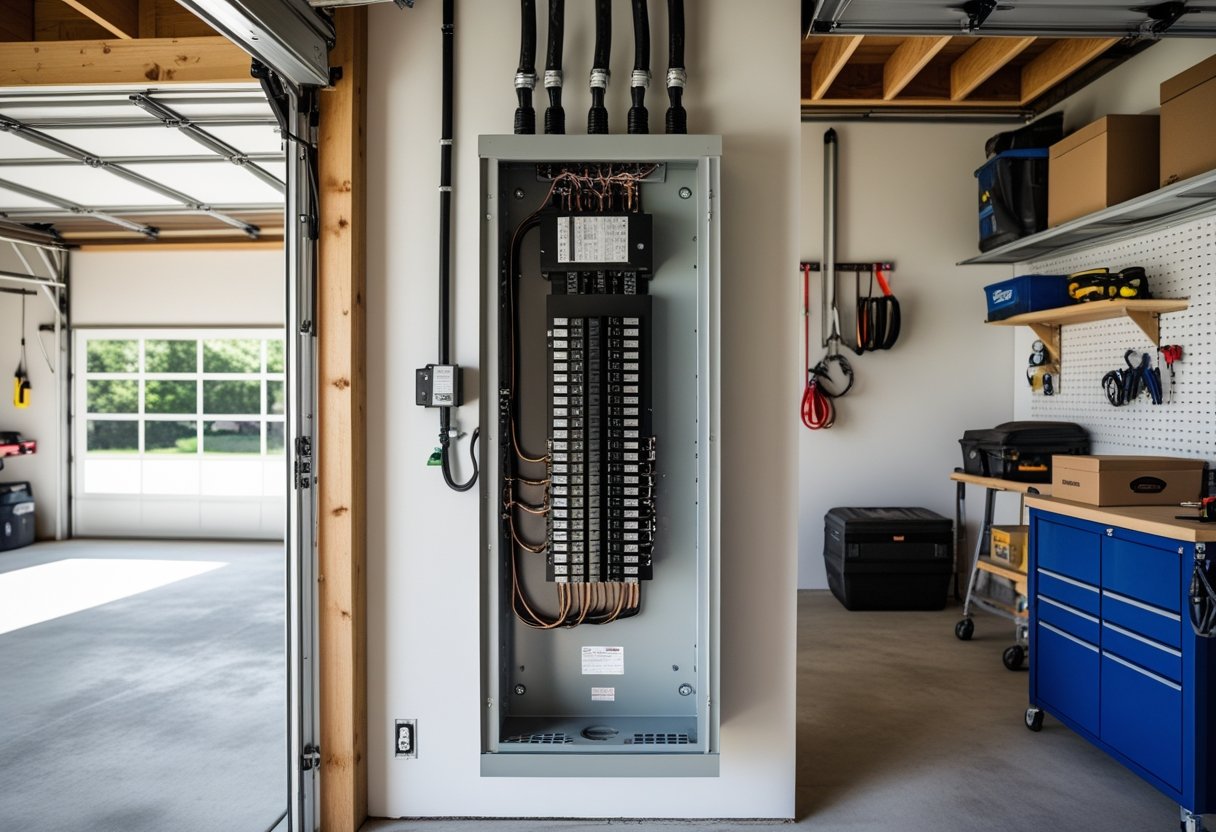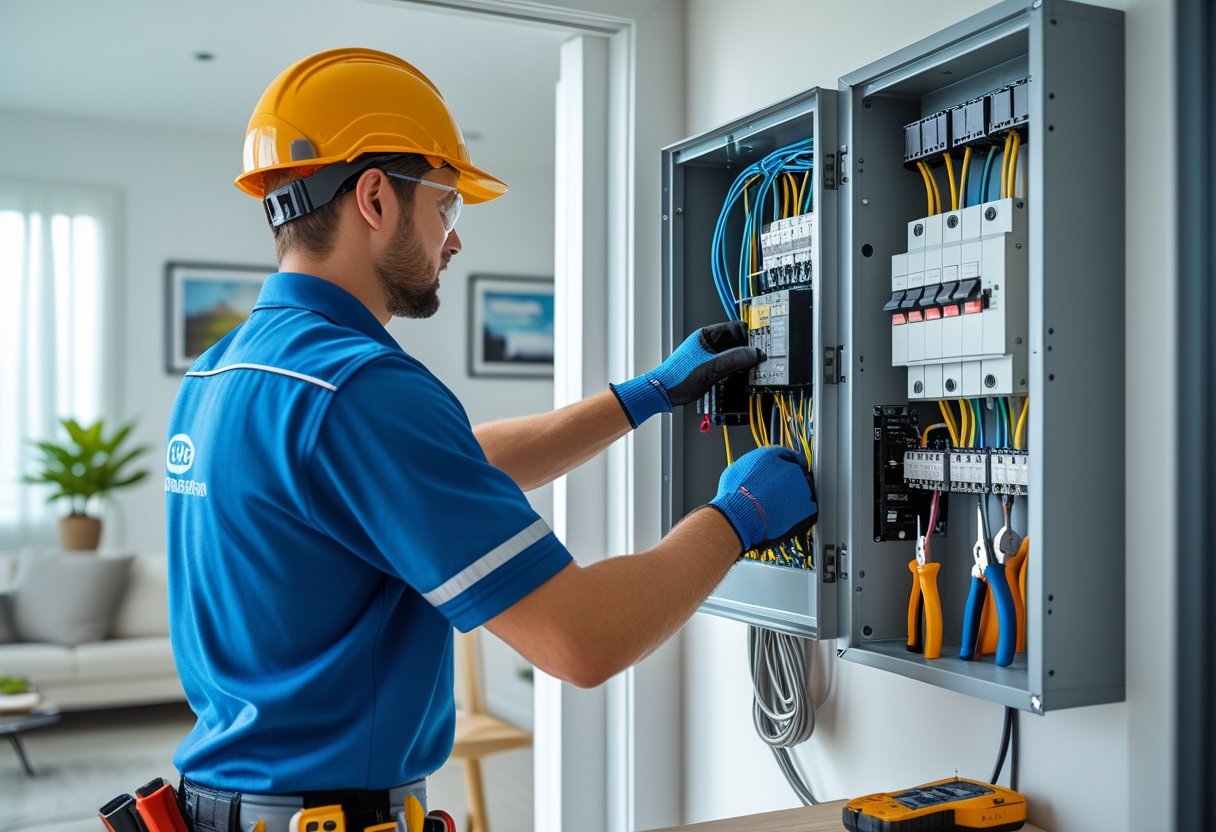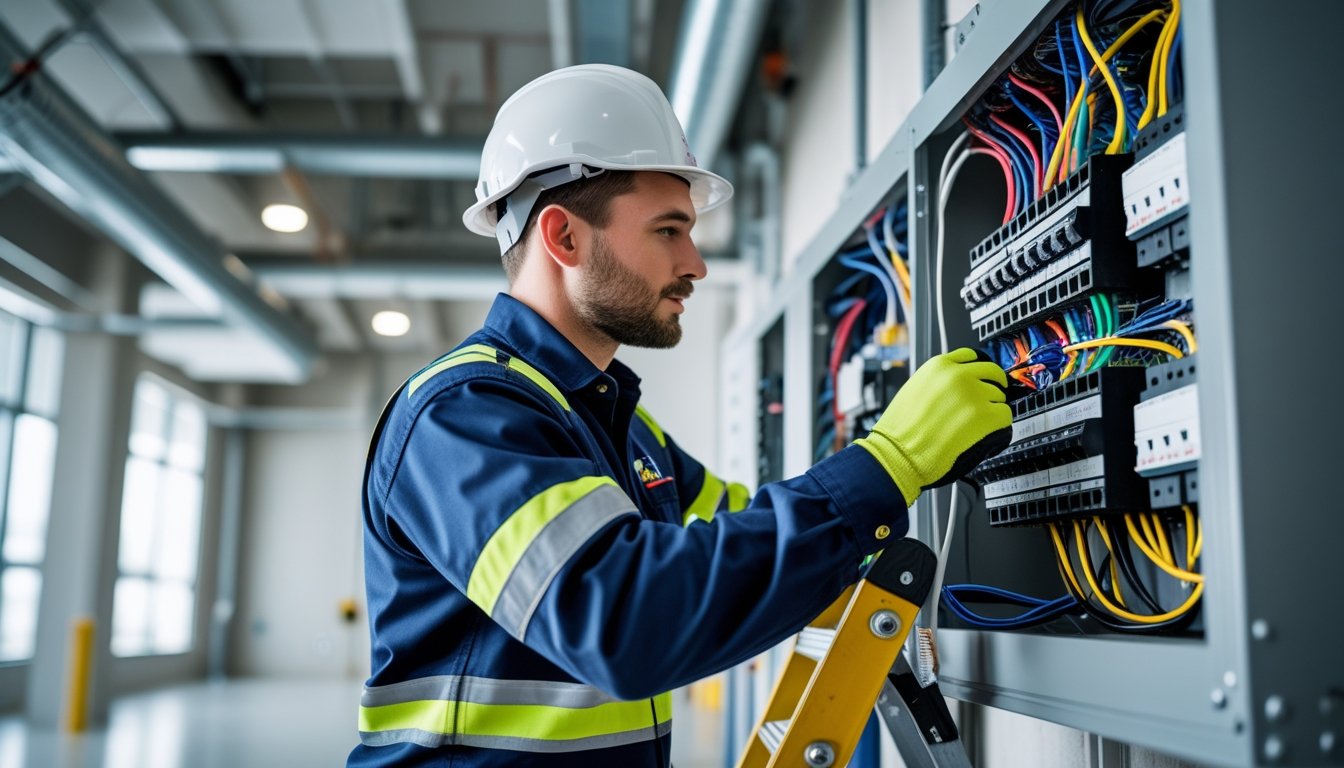Installing a home generator can provide invaluable peace of mind when facing unexpected power outages. By following a clear, step-by-step process, you can ensure your home remains powered during emergencies, keeping your family safe and comfortable. With the right preparation and knowledge, you can tackle this project effectively.
As you consider installing a home generator, it’s essential to understand the components involved, including professional guidance for complex setups. AAA Electrical Services can assist you with expert electrical installations tailored to your specific needs. Our experienced team prioritizes safety, ensuring the setup complies with all local codes and regulations.
When you choose to install a home generator, you not only protect your household from disruptions but also add long-term value to your property. Whether you reside in Sacramento, Roseville, or surrounding areas, AAA Electrical Services is here to support you in making your home more resilient against power outages.
Understanding Home Generator Types
When considering a home generator, it's important to recognize the various types available. Each generator serves specific needs based on power requirements and applications. Below are key categories: standby generators, portable generators, whole-house generators, and alternative fuel generators.
Standby Generators
Standby generators automatically turn on during a power outage. They are permanently installed outside your home and hooked up to the electrical system. Most often, they run on natural gas or propane, providing a reliable backup when utility power fails. Brands like Generac are well-known for their quality in this category.
These generators typically come with a transfer switch, ensuring a seamless power supply transition. Installation should be handled by professionals, like those from AAA Electrical Services, to ensure compliance with local codes and optimal placement. Given their convenience, standby generators can considerably enhance your home’s safety and comfort during outages.
Portable Generators
Portable generators offer the flexibility to power tools, appliances, and electronics during outages or outdoor activities. These units are typically powered by gasoline, diesel, or propane, giving you the option to select the most convenient fuel source.
While they are less powerful than standby generators, portable units are compact and easy to store. They can provide ample power for essential needs such as refrigerators or lights. When using them, always ensure you do so outdoors to avoid carbon monoxide buildup, adhering to safety guidelines for your family's protection.
Whole-House Generators
Whole-house generators provide enough power to run all the appliances and systems in your home. They are a type of standby generator designed to meet higher energy demands. These generators are particularly useful during prolonged outages where you need more than just a few essential appliances operational.
Most whole-house systems are diesel or natural gas-powered, ensuring they can run for extended periods. While installation can be more costly, their ability to maintain complete functionality can be invaluable for families, especially in areas prone to frequent outages. For installation and maintenance, AAA Electrical Services offers expert solutions tailored to your specific needs.
Alternative Fuel Generators
Alternative fuel generators serve those looking for eco-friendly power solutions. These generators can operate on fuels like propane, solar, or even biofuels. The use of solar generators is particularly appealing for those seeking sustainable energy options.
While they can be less powerful compared to traditional units, their low environmental impact and potential for operating costs make them increasingly popular. Solar generators, for instance, can be used during camping trips or for home standby power during the day. Families interested in long-term savings and environmental benefits should consider these options seriously.
Evaluating Your Home Power Needs
Understanding your home's power requirements is essential for selecting the right generator. This ensures that you can keep crucial systems and appliances running smoothly during an outage.
Determining Essential Appliances and Systems
Begin by making a list of essential appliances and systems you rely on daily. These typically include:
- Refrigerator: Keeps food fresh and safe.
- Heating/Cooling Systems: Vital for comfort.
- Medical Equipment: Critical for health needs.
- Lighting: Necessary for safety and navigation.
- Communication Devices: Phones and internet connections.
Identify which of these must remain operational during power outages. This prioritized list will help you when calculating your total wattage needs and selecting a generator.
Calculating Wattage Requirements
Once you've listed your essential devices, it's crucial to calculate their total wattage requirements. Use this simple process:
- Check Appliance Labels: Look for wattage specifications on their labels.
- Add Up Running Watts: Calculate the total running watts needed to power all devices simultaneously.
- Account for Surge Watts: Some devices, like refrigerators and air conditioners, may need additional power to start, known as surge wattage. Add this to your total.
For a reliable generator, aim for a model that can handle at least 20-30% more than your calculated watts. This extra capacity ensures safe operation and account for any unanticipated power needs.
Selecting the Right Generator Size
With your wattage calculated, you can choose a generator that meets your needs. Here are common generator sizes based on specific power needs:
- Portable Generators: Ranges from 2,000 to 7,500 watts. Suitable for powering a few essential items.
- Standby Generators: Generally from 5,000 to 20,000 watts or more. Ideal for whole-house coverage.
It's vital to consult with professionals like AAA Electrical Services to assess your requirements accurately. They can help you navigate the selection process, ensuring your generator can provide uninterrupted power supply when needed most. With over 42 years of experience, AAA Electrical Services is committed to your family's safety and peace of mind.
Preparing for Generator Installation
Before installing a home generator, thorough preparation is crucial. You need to consider local codes, choose the best location, prepare a concrete pad, and comply with regulations. These steps will help ensure a smooth installation process and enhance home safety.
Navigating Zoning and Building Codes
Understanding local zoning and building codes is essential before installation. These regulations can vary significantly based on your location. Check with your local government or building department for requirements specific to your area.
In most cases, you will need a permit to install a generator. This ensures compliance and helps avoid fines. Generators might also have restrictions regarding noise levels or placement, especially in residential neighborhoods.
It's advisable to consult professionals like AAA Electrical Services to assist with navigating these requirements and simplifying the process.
Choosing a Suitable Location
Selecting the right location for your generator is critical for both functionality and safety. Choose a spot that is close to the electrical panel but away from windows and vents to prevent exhaust fumes from entering the home.
Ensure the area is level and easily accessible for maintenance. Factors such as drainage are also important; consider avoiding low-lying areas to prevent flooding. Remember, the generator should be placed in a location that minimizes noise disruption to your household and neighbors.
Laying a Concrete Pad
Creating a sturdy foundation is essential to ensure your generator operates effectively. A concrete pad serves as a stable base that will protect the unit from shifting or settling over time.
The pad should extend several inches beyond the generator's dimensions. A thickness of at least 4 inches is standard for residential units. This installation not only aids stability but also helps in drainage.
If you're unsure about the installation, AAA Electrical Services can help make sure your pad meets all requirements for both safety and durability.
Addressing Local Regulations
Local regulations may impose specific requirements for generator installation, including setbacks from property lines and restrictions on fuel types. Investigate these regulations to ensure compliance and avoid potential legal issues.
You may need to coordinate with utility companies regarding connections and restrictions related to backfeeding power into the grid. Failure to adhere to regulations can lead to penalties, or worse, installation issues after the fact.
Always prioritize safety and compliance when planning your generator installation. Engaging a licensed professional can simplify this process and ensure that your generator is safe, efficient, and legal to operate in your area.
Installation Steps for a Home Generator
Installing a home generator involves several key steps to ensure safety and reliability. It's important to properly set up the transfer switch, connect to your electrical panel, install a power inlet box, and integrate the fuel supply. Each step is crucial for a successful installation, and here are the details to guide you through the process.
Setting Up the Transfer Switch
The transfer switch is essential for safely connecting your generator to your home’s electrical system. You can choose between a manual transfer switch or an automatic transfer switch, depending on your preference and needs.
- Location: Select a dry, accessible spot near your main electrical panel.
- Mounting: Secure the transfer switch to a wall using appropriate anchors.
- Wiring: Connect the transfer switch to your electrical panel using a suitable cable. Use a conduit to protect the wiring.
- Labeling: Clearly label each circuit controlled by the switch to avoid confusion during operation.
This setup allows you to switch your home’s power source from utility to generator efficiently when needed. For expert installation, consider reaching out to professionals like AAA Electrical Services, who specialize in generator installation.
Connecting to the Electrical Panel
Once the transfer switch is installed, connecting it to the electrical panel is the next step. This process involves creating a reliable electrical connection.
- Disconnect Power: Always turn off the main breaker to ensure safety while working.
- Connect Wires: Use appropriate gauge wires to connect the transfer switch to the designated circuits in your electrical panel.
- Follow Codes: Adhere to local electrical codes to ensure compliance and safety.
- Testing: After connections are complete, turn the power back on and test the switch to verify that it functions properly.
By ensuring a secure connection, you can maintain safety and reliability in your home’s electrical system. AAA Electrical Services can assist you with this critical step to ensure everything meets safety standards.
Installing the Power Inlet Box
The power inlet box is the point where your generator’s output connects to your home’s electrical system. Proper installation is vital for efficient operation.
- Placement: Install the power inlet box outside your home in a location accessible to your generator.
- Wiring: Connect the inlet box to the transfer switch using heavy-duty electrical cables that can handle the generator’s output.
- Sealing: Ensure the inlet box is weatherproof and sealed to prevent moisture intrusion.
- Testing: After installation, test the box for proper operation during a power outage to confirm everything functions as intended.
Choosing a reliable outlet box can enhance performance and safety during power outages.
Integrating Fuel Supply
Proper fuel supply integration is necessary for your generator to operate effectively.
- Fuel Type: Identify whether your generator uses propane, natural gas, or diesel.
- Tank Setup: Install a fuel tank or connection per the generator's specifications and local codes.
- Connecting Lines: Ensure all lines are secure and leak-proof, utilizing appropriate fittings and hoses.
- Safety Checks: After installation, check for leaks and ensure the fuel supply is sufficient for the generator’s operation.
Properly integrating the fuel supply will ensure your generator runs smoothly when needed. For peace of mind and professional assistance, consider using AAA Electrical Services for your generator installation and related services.
Testing and Maintaining Your Home Generator
Regular testing and maintenance are essential to ensure your home generator operates efficiently and safely during power outages. Keeping a systematic approach to both can help you avoid unexpected failures and enhance the longevity of your generator.
Initial System Testing
Before relying on your generator, conduct thorough testing to confirm it operates correctly. Start by ensuring it's installed properly and that all connections are secure. Run the generator for about 30 minutes under load to assess its performance.
During this test, check for any unusual noises or vibrations. Ensure the electrical load matches the generator’s capacity to prevent overheating. Revisit manufacturer guidelines for testing protocols to maintain safety.
Record the test results for future reference and consult professionals like AAA Electrical Services if any discrepancies arise. Regular testing should be part of your safety plan against power outages.
Ongoing Generator Maintenance
Establish a maintenance schedule to keep your generator in top condition. At a minimum, inspect it every six months. Tasks should include checking fuel levels, changing the oil, and cleaning or replacing air filters. Regular battery tests are also crucial to ensure reliability.
Keep the generator clean and free from debris, especially around the air vents and fuel lines. This cleanliness helps maintain optimal airflow and cooling.
Consider documenting all maintenance activities, including dates and services performed, which can help in identifying any patterns or issues. For comprehensive support, reach out to AAA Electrical Services for expert maintenance options tailored to your needs.
Ensuring Long-Term Safety
Safety is paramount when it comes to generator use. Regularly inspect electrical connections to prevent wear and ensure all components are functioning correctly. Use a surge protector to shield your home from power spikes.
Additionally, check for fuel leaks and ensure your generator is ventilated properly to avoid carbon monoxide buildup. Install carbon monoxide detectors nearby as an added safety measure.
Finally, familiarize yourself with the generator’s manual and follow local regulations concerning installation and maintenance. If you’re uncertain, consult professionals, ensuring that your home’s safety is never compromised.
Frequently Asked Questions
Installing a home generator involves several technical considerations, regulations, and costs. Below are common questions homeowners have when facing the installation process.
What are the proper steps for installing a whole house generator transfer switch?
Begin by selecting a suitable location for the transfer switch, ensuring it adheres to local codes. Install the switch adjacent to your main electrical panel and connect it to the generator. Following that, conduct necessary electrical wiring safely, ensuring all connections are secure and proper. For guidance, consider consulting with professionals at AAA Electrical Services.
Is obtaining a permit necessary for whole house generator installation and where do you apply?
Yes, a permit is typically required for whole house generator installations. You should check with your local building department or city website for specific application procedures and guidelines within your area. It is crucial to comply with local regulations to ensure safety and legal adherence.
Could you provide a typical wiring diagram for a whole house generator?
A typical wiring diagram includes connections from the generator to the transfer switch and then to the house’s electrical panel. This setup often requires specific labeled circuits for different systems in your home. For an accurate diagram tailored to your setup, it's advisable to engage with licensed electricians.
What is the estimated cost range for professional whole house generator installation?
The cost for installing a whole house generator varies widely based on factors like generator size and installation specifics. On average, installation costs range from $3,000 to $7,000, including the generator itself and labor. For a precise estimate, consult experts at AAA Electrical Services who provide flat-rate pricing without surprises.
How far does a generator need to be installed from the house to comply with code?
Most codes require that a generator be placed at least 5 to 10 feet away from windows, doors, and ventilation openings. This distance ensures proper ventilation and reduces the risk of carbon monoxide exposure. Always verify local regulations for exact distances.
What are the safety considerations when connecting a portable generator to your home?
When using a portable generator, avoid backfeeding into the home’s electrical system, which can cause dangerous voltage spikes. Use a properly rated transfer switch to connect the generator safely to your home. Ensure the generator is located outdoors, away from living areas, to prevent carbon monoxide buildup.





